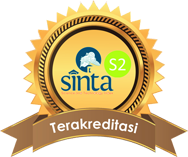Chemistry Students’ Understanding of Lewis Structure, VSEPR Theory, Molecular Geometry, and Symmetry: A Cross-Sectional Study
DOI:
https://doi.org/10.15575/jtk.v8i1.24410Keywords:
chemistry students, cross-sectional study, understanding chemical conceptsAbstract
References
Achuthan, K., Kolil, V. K., & Diwakar, S. (2018). Using virtual laboratories in chemistry classrooms as interactive tools towards modifying alternate conceptions in molecular symmetry. Education and Information Technologies, 23, 2499–2515. https://doi.org/10.1007/s10639-018-9727-1
Barke, H.-D., & Engida, T. (2001). Structural chemistry and spatial ability in different cultures. Chemistry Education Research and Practice, 2(3), 227–239. https://doi.org/10.1039/B1RP90025K
Carlisle, D., Tyson, J., & Nieswandt, M. (2015). Fostering spatial skill acquisition by general chemistry students. Chemistry Education Research and Practice, 16(3), 478–517. https://doi.org/10.1039/C4RP00228H
Crandell, O. M., & Pazicni, S. (2023). Leveraging cognitive resources to investigate the impact of molecular orientation on students’ activation of symmetry resources. Chemistry Education Research and Practice, 24(1), 353–368. https://doi.org/10.1039/D2RP00164K
Desseyn, H. O., Herman, M. A., & Mullens, J. (1985). Molecular geometry. Journal of Chemical Education, 62(3), 220. https://doi.org/10.1021/ed062p220
Dias, L. A. L., & Faria, R. B. (2020). Practical Decomposition of Irreducible Representations: Applications to Molecular Vibrations and Molecular Orbitals. Journal of Chemical Education, 97(8), 2332–2337. https://doi.org/10.1021/acs.jchemed.0c00435
Dinsa, M. T., Woldamariam, G. S., & Dinsa, D. T. (2022). The Influence of Gender and Study Duration on EFL Learners’ Speaking Strategies Use. International Journal of Language Education, 6(1), 10–24.
Duda, M., Rafalska-Åasocha, A., & Åasocha, W. (2020). Plane and Frieze Symmetry Group Determination for Educational Purposes. Journal of Chemical Education, 97(8), 2169–2174. https://doi.org/10.1021/acs.jchemed.0c00093
Habiddin, H., & Nofinadya, S. A. (2021). The Multi-Tier Instrument in the Area of Chemistry and Science. In Insights Into Global Engineering Education After the Birth of Industry 5.0 (pp. 1–17). IntechOpen. https://doi.org/10.5772/INTECHOPEN.100098
Habiddin, H., & Page, E. M. (2019). Development and validation of a four-tier diagnostic instrument for chemical kinetics (FTDICK). Indonesian Journal of Chemistry, 19(3), 720–736. https://doi.org/10.22146/ijc.39218
Harle, M., & Towns, M. (2011). A review of spatial ability literature, its connection to chemistry, and implications for instruction. In Journal of Chemical Education. https://doi.org/10.1021/ed900003n
Hervas, M., & Silverman, L. P. (1991). A magnetic illustration of the VSEPR theory. Journal of Chemical Education, 68(10), 861. https://doi.org/10.1021/ed068p861.2
Kaufmann, I., Hamza, K. M., Rundgren, C.-J., & Eriksson, L. (2017). Developing an approach for teaching and learning about Lewis structures. International Journal of Science Education, 39(12), 1601–1624. https://doi.org/10.1080/09500693.2017.1342053
Kiernan, N. A., Manches, A., & Seery, M. K. (2021). The role of visuospatial thinking in students’ predictions of molecular geometry. Chemistry Education Research and Practice, 22(3), 626–639. https://doi.org/10.1039/D0RP00354A
Kusumaningdyah, R., Devetak, I., Utomo, Y., Effendy, E., Putri, D., & Habiddin, H. (2023). Teaching Stereochemistry with Multimedia and Hands-On Models: The Relationship between Students’ Scientific Reasoning Skills and The Effectiveness of Model Type. Center for Educational Policy Studies Journal, 27.
Liu, R. S. H. (2005). “You’re Repulsive!â€â€”Teaching VSEPR in a Not-So-Elegant Way. Journal of Chemical Education, 82(4), 558. https://doi.org/10.1021/ed082p558
Miras, A., Cota, A., & MartÃn, D. (2022). GESUS, an Interactive Computer Application for Teaching and Learning the Space Groups of Symmetry. In Education Sciences (Vol. 12, Issue 2). https://doi.org/10.3390/educsci12020085
Moravcová, V., Robová, J., Hromadová, J., & Halas, Z. (2021). Students’ understanding of axial and central symmetry. Journal on Efficiency and Responsibility in Education and Science, 14(1 SE-Research Paper), 28–40. https://doi.org/10.7160/eriesj.2021.140103
Nassiff, P., & Czerwinski, W. A. (2015). Teaching Beginning Chemistry Students Simple Lewis Dot Structures. Journal of Chemical Education, 92(8), 1409–1411. https://doi.org/10.1021/ed5007162
Niece, B. K. (2019). Custom-Printed 3D Models for Teaching Molecular Symmetry. Journal of Chemical Education, 96(9), 2059–2062. https://doi.org/10.1021/acs.jchemed.9b00053
Rahmawati, Y., Dianhar, H., & Arifin, F. (2021). Analysing Students’ Spatial Abilities in Chemistry Learning Using 3D Virtual Representation. In Education Sciences (Vol. 11, Issue 4). https://doi.org/10.3390/educsci11040185
Rattanapirun, N., & Laosinchai, P. (2021). An Exploration-Based Activity to Facilitate Students’ Construction of Molecular Symmetry Concepts. Journal of Chemical Education, 98(7), 2333–2340. https://doi.org/10.1021/acs.jchemed.1c00191
Ruiz, G. N., & Johnstone, T. C. (2020). Computer-Aided Identification of Symmetry Relating Groups of Molecules. Journal of Chemical Education, 97(6), 1604–1612. https://doi.org/10.1021/acs.jchemed.9b01085
Savchenkov, A. V. (2020). Designing Three-Dimensional Models That Can Be Printed on Demand and Used with Students to Facilitate Teaching Molecular Structure, Symmetry, and Related Topics. Journal of Chemical Education, 97(6), 1682–1687. https://doi.org/10.1021/acs.jchemed.0c00192
Thayban, T., Habiddin, H., Utomo, Y., & Muarifin, M. (2021). Understanding of Symmetry: Measuring the Contribution of Virtual and Concrete Models for Students with Different Spatial Abilities. Acta Chimica Slovenica, 68(3). https://doi.org/10.17344/acsi.2021.6836
Tiettmeyer, J. M., Coleman, A. F., Balok, R. S., Gampp, T. W., Duffy, P. L., Mazzarone, K. M., & Grove, N. P. (2017). Unraveling the Complexities: An Investigation of the Factors That Induce Load in Chemistry Students Constructing Lewis Structures. Journal of Chemical Education, 94(3), 282–288. https://doi.org/10.1021/acs.jchemed.6b00363
Tuvi-Arad, I., & Blonder, R. (2010). Continuous symmetry and chemistry teachers: Learning advanced chemistry content through novel visualization tools. Chemistry Education Research and Practice, 11, 48–58. https://doi.org/10.1039/c001046b
Downloads
Published
How to Cite
Issue
Section
Citation Check
License
Authors who publish with this journal agree to the following terms:
- Authors retain copyright and grant the journal right of first publication with the work simultaneously licensed under a Creative Commons Attribution-ShareAlike that allows others to share the work with an acknowledgement of the work's authorship and initial publication in this journal.
- Authors are able to enter into separate, additional contractual arrangements for the non-exclusive distribution of the journal's published version of the work (e.g., post it to an institutional repository or publish it in a book), with an acknowledgement of its initial publication in this journal.
- Authors are permitted and encouraged to post their work online (e.g., in institutional repositories or on their website) prior to and during the submission process, as it can lead to productive exchanges, as well as earlier and greater citation of published work (See The Effect of Open Access).








